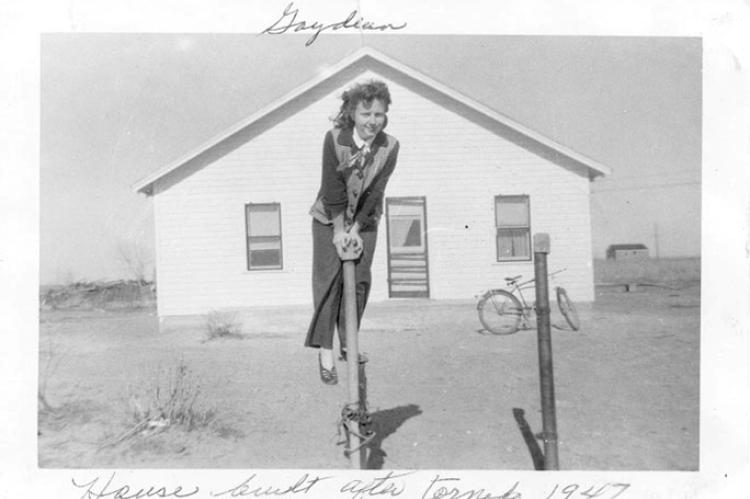The April 9, 1947, Higgins Tornado Anniversary
A reprint of Cathy Ricketts’ On the Cusp column
published in the April 7, 2016, edition of The Canadian Record
April can bring blizzards, tornadoes, all degrees of rain, as well as many shades of drought. My husband Doug has the floor with two stories from a historic weather event coming up on an anniversary.
IN ADDITION to being a world-class sculptor, the late Gerald Sanders of Pampa had a long career as a lineman for Bell Telephone. Back in the spring of 1947, he and his partner were working a trouble call in the Eastern Panhandle when they learned about the tornado that had plowed through Glazier and Higgins. They were probably the first communications personnel to arrive in Higgins, where they saw that the devastation was so complete that any phone service would have to wait on daylight and a lot more help. The only phone line they located was a 100-yard section that had a perfect figure-eight knot tied in the middle.
They made their way through the rubble on the west side of Higgins until they came to the remains of the hotel. The scene was lit by the many fires that burned all over town. A group of survivors stood looking down into the debris-filled basement, yelling that there was a baby trapped down there.
Gerald and his partner bailed off into the splintered lumber and started digging with their bare hands. Sure enough, they could hear the baby crying. Eventually they reached the child, who apparently had only minor injuries. Mother and baby were reunited and Gerald went on to work many long days restoring phone service.
About 18 years later, Gerald headed to the Pampa hospital late in the day to check in on his daughter who was a patient there. She shared a semi-private room with another young woman. When Gerald walked into the room, the mother of the young woman burst into tears. Not knowing what was going on, Gerald started feeling mighty uncomfortable.
Finally, after the mother was able to compose herself, she hugged Gerald. She then told him that she would never forget his face, because he was the reason that her daughter was alive and lying in that hospital bed. She was the child that he had rescued from the hotel basement on April 9, 1947.
*******
THIS IS EVEN CLOSER TO HOME and comes from my mother’s family, the Litchfields. The ‘47 tornado that plowed a path of death and destruction for 221 miles began at 5:42 pm in White Deer, Texas, and disappeared 6 miles north of Nashville, Kansas, about 11 pm. According to the National Weather Service, an analysis of the event determined later that there were at least five or six tornadoes in the outbreak (or the multiple vortex storm). The Glazier-Higgins-Woodward tornado is classified as the sixth deadliest in the U.S.
ACROSS THE RAILROAD TRACKS in Higgins on April 9, my mother [Gaydean Bucher]—then Gaydean Litchfield and an eighth grader—was at home with her parents and six of her brothers and sisters. Her father, Verl D., watched from the front porch, as the evening grew increasingly dark.
About 7:45 the tornado hit Higgins. People could be heard calling out all over town. Fires from broken gas lines began to light up the town. The Litchfields made it to the back bedroom. Verl D. tried to hold the door; everybody else was on the bed. The house lifted up and blew apart, dumping the whole family on the ground. Gaydean’s mother, Leila, thought the world was coming to an end with explosions and fireballs going up all across town. They all had gravel and mud driven into their skin. Gaydean’s sister Nona had some bad cuts on her face. Gaydean, hit in the head by a flying cement block from the foundation, was the most seriously injured.
Meanwhile, Howard and Elma Lue Word were watching the skies from their place several miles out in the country southeast of Higgins. They got a phone call telling them about the tornado, so Howard went to see about his parents who lived just south of the Litchfields. He began searching through the rubble in the vicinity. There were no landmarks. Everything on the south side of town was gone. His mother was nowhere to be found.
He did come across the Litchfield family, so Nona and Gaydean, along with a badly injured bachelor neighbor, were loaded in Howard’s car for the trip to the Shattuck, Oklahoma, hospital. The neighbor died on the way. Gaydean, sick from her concussion, was not aware of much during the trip. Once at the hospital, Howard searched through the dead and injured, locating his mother—alive, but badly hurt.
The official death toll in Higgins is listed as 45. The local count has always been 53 killed. Howard’s mother remained in a coma for six weeks and had her left arm amputated, but she eventually recovered. In all the confusion, Gaydean’s name somehow wound up on the dead list. So, until she was able to catch a ride back to Higgins two days later, many in the community thought she had died at the hospital.
Fifty years after the tornado, Clarence and Elma Lue Case of Lipscomb happened to be watching TV when Gaydean Bucher was interviewed by a reporter from an Amarillo station. She described her experiences during the storm and added that she had always wondered who the man was who gave her the ride to the hospital, since she had only a hazy memory of that trip. A few days after the interview, Elma Lue visited with Gaydean and told her late husband Howard Word’s story to help fill in the blanks.


